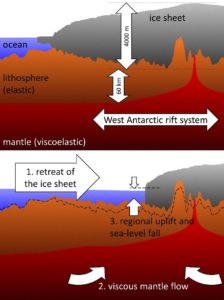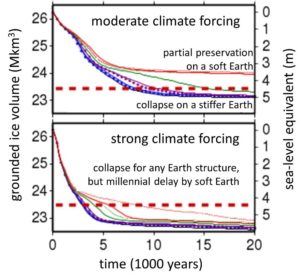A few months ago, Isabel explained in this blog why the glaciers of the Amundsen Sea Embayment, part of the West Antarctic Ice Sheet, are vulnerable to warmer ocean waters. They are subject to the so-called Marine Ice Sheet Instability because they are flowing over bedrock several hundreds of metres below sea level, which is also deepening towards the interior of the ice sheet: it is hypothesized that this situation will lead to runaway ice loss once they start to retreat. Several studies so far have raised concerns that this catastrophic collapse might have already started, potentially adding 4.5m to sea levels if the whole West Antarctic Ice Sheet was to follow.
It is, however, not only the ice sheet that could be rapidly evolving in this part of the world, but also the solid Earth. A shrinking ice sheet unloads the Earth underneath, which responds by so-called glacial-isostatic adjustment, a delayed rebound due to viscous flow in the Earth’s mantle. The Earth’s surface in vast parts of North America and North Europe, for example, is still uplifting at rates of up to 1 cm per year following the deglaciation of their major ice sheets since the Last Glacial Maximum about 20,000 years ago.
Another process in this context, smaller in magnitude but still important, is a drop in regional sea level associated with the weakening of the gravitational pull exerted on the ocean water when an ice sheet loses mass. Returning to the West Antarctic Ice Sheet, both of these processes would make the ocean shallower where it meets the ice sheet and so act against the Marine Ice Sheet Instability, potentially preserving the ice sheet:
As it happens, the Earth underneath the West Antarctic Ice Sheet is in a way rather soft: the West Antarctic rift system is characterized by hotspots, volcanism, and – as is defining for rifts – spreading between plate boundaries. Uplift rates and seismic surveys, not really easy to access in this icy environment, indicate that we can expect extraordinarily low viscosities, especially in the Amundsen Sea Embayment, which could make the rebound just rapid enough to preserve the West Antarctic Ice Sheet or at least delay its collapse.
I addressed this question as part of my recently finished PhD project, and we tested the influence of the rebound with a coupled numerical model for ice and Earth dynamics. It turns out (similar here) that, given low viscosities in the asthenosphere (the uppermost upper mantle, if you want), the rebound can indeed be fast enough for the retreat being limited to the Amundsen Sea Embayment, if the climatic forcing of the ice sheet retreat is moderate:
Under stronger climatic forcing, the soft Earth structure of the rift system would at least hold the remnants of the West Antarctic Ice Sheet for a few thousand years longer than a stiffer Earth structure associated with for example the East Antarctic craton would.
However, two things are also apparent in these results. First, it is the strength of the climatic forcing, or more specifically of ocean warming, which mainly defines whether the West Antarctic Ice Sheet would stay intact in the future in our simulations. The ice sheet will only be preserved by rebound if the ice retreat occurs slowly enough for the rebound to exceed a certain threshold before the ice is at its point of no return. Second, the effect of different Earth structures does only become apparent after a few millennia. West Antarctic contributions to sea-level rise today or in the near future will probably not be affected by this, and the far future of the Earth’s climate system is not very well constrained in view of human interaction with climate and an anticipated start of the next glacial period at some point in the far future.
The interesting reverse side of this potentially stabilizing situation is that an active Earth underneath an active ice sheet could well serve as an additional driver of ice loss through melting at its warm base. So, while the whole ice/Earth feedback system is interesting and obviously important, it still needs to prove how capable it is of acting in line with or against trends in the climate system when it comes to ice sheet stability.


